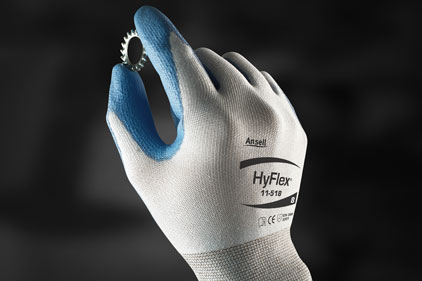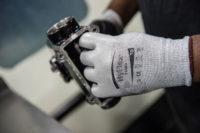What is tactility and why do my workers need gloves with features that promote tactility?
Tactility is to the fingers what dexterity is to the hands. The term is often called tactile sensitivity and refers to touch perception or sensation in the fingertips that allows workers to handle objects safely and efficiently.
Tactility is essential for assembly operators and others who work with objects of various shapes and sizes in dry, wet and oily environments. The gloves these workers wear must also fit, feel and function like a second skin so workers experience no restriction in their movements.
What are specific applications in which workers can benefit from greater tactility?
Individuals who handle small parts — bolts, nuts and screws — can benefit from increased tactile sensitivity as can those who work with small hand or power tools, including screwdrivers, saws, drills and bits and sockets. Gloves that increase tactile sensitivity also benefit workers who record data using a pen or a keyboard so they can perform these tasks without constantly removing and donning their gloves.
Individuals who work in a packing area, for example, pick up products and place them in a box or container, print out an address label and affix it to the container. They typically record the shipment on a computer and place the container in an area for pickup. Workers who wear gloves with sufficient tactility to perform all of these functions without removing their gloves will require less time to complete the task, which helps boost productivity.
What are potential consequences when workers do not have sufficient tactility to perform their jobs?
Workers who do not have the tactility they need to handle small and slippery objects are more likely to drop the objects, which can cause injuries such as cuts or result in expensive product re-work or equipment repairs. Lack of tactility can also lead to hand fatigue and even cramping because the fingers are unable to easily grasp objects.
Employees, for example, who work in automotive assembly, engine assembly or white goods/durable goods assembly where they constantly insert small screws into sheet metal are likely to suffer hand fatigue if they do not have sufficient tactility to securely grasp and turn the screws.
Lack of tactility has also been associated with repetitive motion injuries (RMI). Workers who continuously pick up small screws to assemble metal parts in air conditioning units, for example, are at risk for an RMI if they do not have enough tactility to handle the screws without straining. Individuals in riveting and punch operations are also at risk.
Do factors such as double gloving, chemicals, or wet and oily environments decrease tactility?
Definitely. Anything that increases thickness in the fingertips such as gloves that are too large or double gloving can negatively impact tactility.
Wet or oily environments can also decrease tactility. Many small metal parts used in assembly are coated with rust inhibitors that make them lightly oiled or greasy. Workers may strain to handle these parts — or may drop the parts — if they do not have enough tactility to hold the objects with their fingertips.
Do workers typically try to compensate when they do not have sufficient tactility to perform a certain task?
Yes, they often remove their gloves entirely because they believe they can perform the task more efficiently using their bare hands. This creates a donning and doffing issue, which takes them away from the task, and may result in noncompliance. Some workers cut off the tips of their gloves when they do not have sufficient tactility to perform the tasks that are part of their jobs. Both scenarios increase the potential for injuries because the fingers and/or hands are exposed to any hazard that is inherent to the application.
What fabrics, coatings and others features increase work glove tactility?
Thin coatings such as polyurethane and nitrile, synthetic coatings such as Ansell Grip Technology™, and thin, seamless liners made of nylon, lycra or Dyneema® Diamond Technology yarn will enhance tactile sensitivity. Coatings over the fingertips should be smooth rather than crinkled because the latter decreases sensitivity in the fingertips. Gloves with seamless liners also provide greater tactility than those with seams.
As mentioned earlier, proper fit is essential. Gloves that are too bulky — like many cotton, leather and sewn gloves — provide little tactility. Gloves that are too small create pressure on the fingers and hands and cause them to perspire, which can decrease tactile sensitivity.
Because gloves with fabrics and coatings that enhance tactility are often lightweight and comfortable, workers are more likely to wear the gloves throughout their shifts, which results in greater productivity and compliance.
What recommendations can you provide for companies choosing gloves that heighten worker tactility?
Look for thinner gauge liners — such as 15 and 18 gauge — made with the materials and coatings mentioned earlier. Read product specifications carefully because many new generation products incorporate design features and fabrics that enhance dexterity and tactility.
Always provide workers with the right size gloves — one size does not fit all as far as tactility is concerned. Matching the glove to the application will also enhance tactility and ensure worker comfort and compliance.






